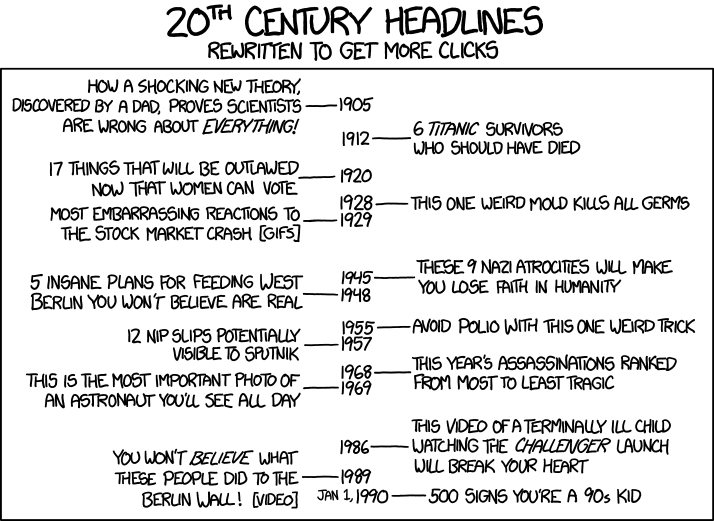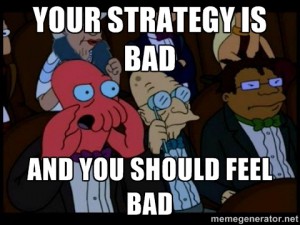Freebooting needs to die: 7 online marketing trends that are ruining the internet
If you’ve spent any time on Facebook in the last couple of years, odds are you’ve come across and fallen victim to a lot of marketing and revenue-generating tactics that pollute your feed, steal from creators, and just generally frustrate you and waste your time. They’re the social equivalent of spam, and they’re ruining the internet.
1. Freebooting
 This term might be new to you, but the practice almost certainly isn’t. Freebooting is the practice of taking media, usually video, that you don’t own, then rehosting it or embedding it on your own page surrounded by ads that make you money. I don’t mean blogs that embed videos for the sake of commentary or illustration–that’s not freebooting–I’m talking about slapping the video on a page with a (usually clickbait) headline and no original content. There are dozens of sites out there that rely almost entirely on embedding others’ YouTube videos on their pages with their ads. The creators of these videos typically receive no benefit from these ads and these sites are profiting off of work that is not theirs.
This term might be new to you, but the practice almost certainly isn’t. Freebooting is the practice of taking media, usually video, that you don’t own, then rehosting it or embedding it on your own page surrounded by ads that make you money. I don’t mean blogs that embed videos for the sake of commentary or illustration–that’s not freebooting–I’m talking about slapping the video on a page with a (usually clickbait) headline and no original content. There are dozens of sites out there that rely almost entirely on embedding others’ YouTube videos on their pages with their ads. The creators of these videos typically receive no benefit from these ads and these sites are profiting off of work that is not theirs.
Even worse than this, though, are pages that wholesale copy and re-upload the content instead of embedding. At least embedding technically automatically links to the original that the creator may have monetized (though really, how many people click the video to watch it on YouTube instead of just in the page). This is theft of the worst sort, since there’s not even a chance that someone will go to the original and make the creator money. This is perhaps the most common definition of freebooting, and it’s regularly done by people and pages who re-upload a video from YouTube to Facebook to monetize it there. You’ve probably watched and shared these videos before.
“But they get the creator exposure!” you say. Call me when exposure can buy groceries. A lot of creators rely on revenue from their videos to make a living. Always link to the original video and never share rehosted content.
2. Clickbait
![]()
 You’ll never believe what this article’s title was originally going to be!
You’ll never believe what this article’s title was originally going to be!
Initially, I was going to call out clickbait in the headline, but on its own, clickbait is mostly just annoying more than it is harmful, so freebooting got the top slot. However, a lot of freebooters rely on clickbait headlines to drive traffic. And the thing about clickbait is that it works, and it works well. Most people just have to know what happens next that will make them have all the feels. Even I can’t resist it sometimes. But mostly I’m just irritated by it, because yeah, I’m pretty sure I will believe what happens next, and I’m not about to waste my precious time to discover that all this waste of bandwidth website did was repost a YouTube video or rehost a photo essay.
But perhaps more offensive than clickbait being used by revenue machines is clickbait being used by reputable news sites. I used to work in news, and maybe I’m old school, but headlines are meant to be informative first and a “hook” second. Not the other way around. So when I see news outlets publishing headlines like, “Study finds these cities best for job seekers,” instead of something more informative like, “Study finds Atlanta, Dallas among top cities for job seekers,” I’m a bit bothered. I get that it’s all about driving clicks and getting ad views these days (I have ads…I like money…), but especially when it comes to potentially important information, the duty to inform comes first. “Doctors warn against arsenic in popular baby food,” will get more clicks than “Arsenic levels in rice cereal too high for babies, doctors say,” but the latter is better at disseminating the vital information to headline skimmers.
Just say no to clickbait. It’s making us all dumber.
3. Click-through articles
If freebooting and clickbait got together and had an ugly, yet slightly less evil baby, click-through articles would be its name. I’ve been seeing this a lot lately from local news sites, where they (presumably) pull content from wire services, host the first couple of paragraphs on their site, and link to the rest of the article at its original source. On its surface, this seems like a perfectly polite thing to do, but when the channel or newspaper posts about the story on social media, it’s indistinguishable from original and/or local content until you click the link. From there, in my experience, when I discover that what would have been important news, had it been local, actually happened on the other side of the country, or an article that I clicked on out of morbid curiosity is going to waste more of my time than I wanted to commit to wasting by making me click on and load another page, I close the tab and go on with my life, figuring that if it’s actually that important, I’ll hear about it later.
The arrangement works out pretty well for news sites, since the originator gets page (and ad) views as does the destination most of the time. But it’s another one of those things that wastes the time and good faith of readers.
4. Unnecessary pagination
While we’re here talking about annoying things news sites do to drive ad views, let’s talk about the phenomenon of dividing up short articles into multiple pages. While this might have made some sense in the days of dialup (short pages load faster, especially if there are images), today, when even most mobile devices have faster connections than what home cable internet was five years ago, this is just a gigantic pain. More page views means more unique ad impressions, which translates to more money…I get it…but when I see an article that starts out with 100-200 words and then has five pages I have to click through to read the whole thing, and there’s no “view on a single page” option? I’m gone. You’ve lost me. If I’m really interested in the subject, I’ll go read about it somewhere else. I don’t like my reading experience interrupted like that.
A variation on this is the unnecessary slideshow, which is often even worse since they’re usually badly coded, don’t work right on mobile devices (if they work at all), provide little actual information (unless you click on the link to the page with the extended information about each item, which often takes you away from the slideshow because someone didn’t code the link to open in a new tab/window), and are a slog to get through if you’re just looking for one specific piece of information.
Pagination is fine if you’ve got a long article. Slideshows are fine if each item is essentially a small article in itself or if the whole thing is image-heavy. But always, always give readers the option to view everything on a single page.
5. Popover ads
I don’t know a single person who doesn’t hate these, and yet, they’re everywhere. There you are, happily a paragraph or two along in an interesting article, when suddenly the page dims and a box appears, “Like us on Facebook! Follow us on Twitter!” The ‘X’ to get rid of it is so tiny that no amount of pinch zooming will ever make it tappable, but you get lucky and hit the mark, but it won’t go away. You can still see the article behind the tint, though, so maybe you’ll just read around it. You scroll down. The box follows you and is now covering the bulk of the content. You try closing it again, except now you’ve clicked on it and you’re taken to their Facebook page, where at this point you’re tempted to cuss them out.
Popover ads. Usually they’re used for “social engagement,” but sometimes they’re actual revenue ads. Either way, they suck. They interrupt the experience, they’re impossible to block (shy of disabling javascript entirely, which is honestly more trouble than it’s worth in most cases), and they’re sometimes impossible to get rid of. The first person who can come to me with a solution to remove these from my browsing experience once and for all gets a million internet points and my undying gratitude.
6. Like/comment/share spam chains
 I honestly don’t quite know what else to call these. They come in a couple of main flavors, and they’re all meant to spread page content to as many timelines as possible. The first presents itself as a sort of poll about some area of interest related to the page with three choices that instructs people to “like for X, comment for Y, share for Z.” The goal behind this is mostly to boost page post engagement numbers so that Facebook’s algorithm will show other posts more often in subscribers’ timelines. Facebook has long since taken steps to discourage this sort of behavior, but it’s still somewhat effective. It’s also timeline pollution for people who don’t subscribe to or have no interest in the subject of the page. Just say no.
I honestly don’t quite know what else to call these. They come in a couple of main flavors, and they’re all meant to spread page content to as many timelines as possible. The first presents itself as a sort of poll about some area of interest related to the page with three choices that instructs people to “like for X, comment for Y, share for Z.” The goal behind this is mostly to boost page post engagement numbers so that Facebook’s algorithm will show other posts more often in subscribers’ timelines. Facebook has long since taken steps to discourage this sort of behavior, but it’s still somewhat effective. It’s also timeline pollution for people who don’t subscribe to or have no interest in the subject of the page. Just say no.
The second type is a “call for likes.” These also turn up on Tumblr a lot. Sometimes they take the form of a sick child or a cute animal or a wounded veteran, other times they latch on to a cause of some sort, are meant as a guilt trip, or are just because someone is bored and looking for attention. “Like and share if you’re against animal cruelty!” “This kid has cancer. If this post gets a million likes, her favorite celebrity will visit her.” “Like this post for no reason.” “America is the most American thing ever! Share if you agree!” “Some other post about something I think is stupid got a lot of likes. Like this post if you think this other thing is more important.” These have the same effect for pages as the other type above, but they also seem to originate with individuals as a means of spreading a certain ideology or expressing certain opinions. But generally, they’re the social equivalent of a chain email, and you know how much everyone hates those.
The third type takes advantage of people not knowing how Facebook works. A lot of times, you’ll see a link to a recipe or a how-to (which is sometimes freebooted content) that says, “Share to save this to your page!” And once upon a time, back in the early days of Facebook, sharing something to your page that you wanted to look at or have for later was the easiest and only way to do that without having to leave Facebook. But now, Facebook actually has a ‘Save for later’ option for most links in the little down arrow menu in the top right corner of the post. There are some versions of the Facebook app and mobile site (particularly on older devices) that don’t have this feature for some reason, but for most Facebook users, this is a thing you can use to save something for later. Because sometimes you don’t want to share that article about natural home colon cleansing with all of your friends. (Disclaimer: Please do not attempt natural home colon cleansing. It’s not good for you, no matter what the article claims.)
7. Top # lists that have more items than they need
I figured this would be the best thing to end my list with. Lists are a popular and effective blogging format. People like to click on them. People like to read them. People are much more likely to put up with all of the crap in this list while clicking on them and reading them. But sometimes you’re wondering what the author was smoking when she included half of the items. Sometimes they’re irrelevant. Sometimes they’re repetitive. Sometimes you’re pretty sure the publisher demanded a top 20 list when really it should have been a top 5.
Just make your list with all of the items that you think are actually relevant, and the number you end up with is the number you use. Though if you can’t think of at least four items, you might want to reconsider the format for your article. Three is a great number, but it makes for a rather anemic list.
tl;dr:
 If you’re guilty of any of the above: Look at your life; look at your choices. Maybe you’re making bank with low-hanging fruit. But is the gradual destruction of the usefulness of the social internet what you really want in the long term? Do you really want to create a wasteland of mindless guerrilla marketing content?
If you’re guilty of any of the above: Look at your life; look at your choices. Maybe you’re making bank with low-hanging fruit. But is the gradual destruction of the usefulness of the social internet what you really want in the long term? Do you really want to create a wasteland of mindless guerrilla marketing content?
And consumers: Do you really want to let them?

